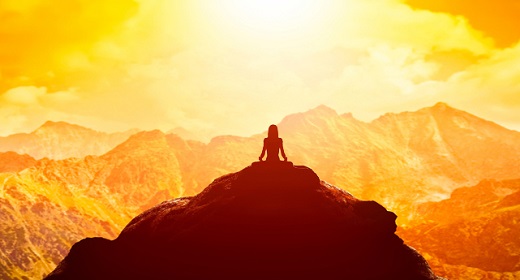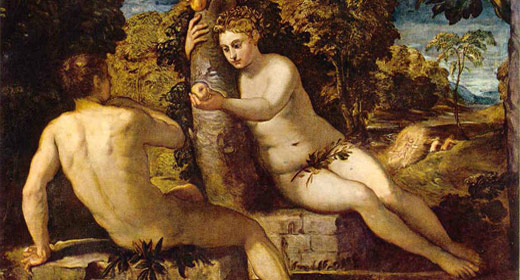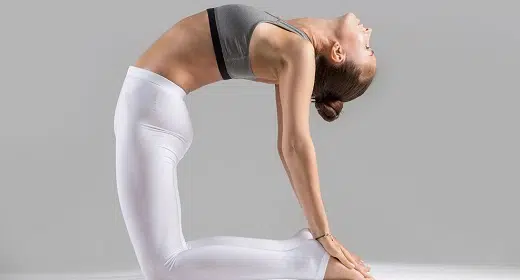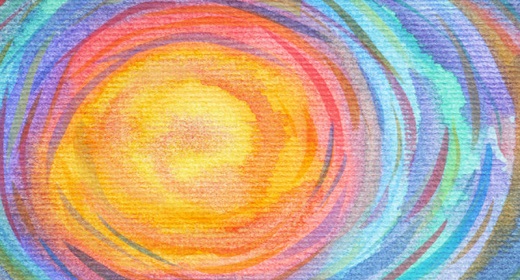by Amanda Carter: Wheel Pose (Urdhva Dhanurasana) is a full body position that requires both strength and flexibility in your arms, legs, core, and spine..
The backbend may appear simple to the outside viewer, but the use of a variety of muscle groups (as well as the need for flexibility) makes it a more challenging pose to perform. While it may be tempting to go straight into the pose, it’s best to work your way up to it by practicing poses that target the right muscles and improve your flexibility. The following poses are some of the best tools a yogi can use to get in the best shape for Wheel Pose.
Plank Pose

Core and arm strength is extremely important for Wheel, and Plank Pose (Palakasana) will help fire up those muscles and prepare you for the pose. Additionally, you’ll get engagement in your legs and the muscles around your spine, which are equally as important in holding a strong Wheel.
Begin in a tabletop position on your hands and knees. Your wrists should be stacked underneath your shoulders, with your palms pressing firmly into the mat.
With your gaze down between your hands, tuck your toes and step your legs back, so that you are in a straight line from your head to your heels.
Bring awareness to your hips, and make sure they are not sinking low or raised up too high. Ensure that your shoulders are still stacked over your wrists, and focus on pressing through the thumb and index fingers.
Continue to press your thighs up towards the ceiling, while still maintaining a straight line, and drive your tailbone towards your heels.
After holding for 30 seconds to a minute (or longer, if you are trying to build up stamina), lower back down to your knees to release.
Chair Pose

Chair Pose, or Utkatasana, is a powerful pose that strengthens the legs and lengthens the spine, while also building up stamina.
To get into the pose, start by standing with your feet parallel to each other. They can be touching, or hips-width distance apart for more support.
On an inhale, reach your arms above your head with your palms facing together.
On an exhale, bend your knees, focusing on getting them as parallel to the ground as possible. As you are doing this, drive your hips backwards and towards the ground.
Your torso should be slightly leaning forward. Be mindful of keeping your shoulders away from your ears, and firm your shoulder blades together. Ensure that you can still see your toes past your knees. You should continue to drive your tailbone down, while still keeping your spine elongated.
Stay in this pose for approximately 30 seconds to a minute, and release into standing.
Downward Dog

A Downward Dog (Adho Mukha Svanasana) is full body stretch and strengthener that will help keep you safe while performing wheel pose. It stretches out your hands and hamstrings, while also strengthening your legs and shoulders.
Start from a tabletop position, with your hands and knees on the ground. On an exhale, engage your core, curl your toes, and lift your knees off the ground, working towards straight legs.
Your head should remain active, with your gaze focused in between your legs. Continue to push through your index fingers and thumbs while stretching your tailbone back and up towards the ceiling. You may choose to bend each leg individually to warm up your calves before settling into stillness. Once still, hold the pose for 30 seconds to a minute.
Low Lunge with Quad Stretch

Low Lunges (Anjaneyasana) are great for strengthening and stretching your thighs, glutes, and knees, which are all integral parts of wheel pose. Adding the layer of a quad stretch helps to deepen the stretch in your front thighs, which need to be warmed up for a successful wheel.
From downward dog, step your right foot forward, in between your palms. Lower your left knee onto the ground, and untuck your left toes so that the top of your foot is on the ground. Ensure that your front knee is stacked over your ankle.
You may choose to stay in this position if the stretch is deep enough. You may also bring your arms up above your head on an inhale, and hold the position for 30 seconds to a minute before switching sides.
If you’d like to go deeper with the quad stretch, bring your left heel towards your glutes, and grab onto your ankle with your left hand. Your right hand may remain on the ground by your right foot, or you can choose to rise up and grab your ankle with that hand as well. Hold for 30 seconds, and move onto the opposite side.
Warrior I with Chest Expansion

Warrior I (Virabhadrasana I) helps to further stretch and lengthen the hip flexors and quadriceps. By adding a chest expansion, the shoulders and chest are also opened and stretched, preparing you for the upper backbend component of Wheel.
From a standing position, bring your left foot back behind you on the ground, turning the toes out slightly to the left so that they are on a diagonal line. Your left foot should be fully on the floor. Your front right knee should be bent and stacked over the ankle.
On an inhale, bring your arms up above your head. As you do this, be aware of your hip points, making sure they are on an equal plane facing forward. Be sure that your shoulders are relaxed and away from your ears.
On an exhale, bring your arms behind your back and interlace your hands. As you squeeze your palms together, roll your shoulders back and feel the stretch in the arms, shoulders, and chest. Hold for about 30 seconds, and repeat on the opposite side.
Dolphin Pose

Dolphin Pose (Ardha Pincha Mayurasana) is great for strengthening your shoulders, as well as your core and back.
Starting from plank pose, lower down onto your forearms, clasping your hands together. Begin stepping your feet forward in small steps towards your arms, allowing your hips to raise. You should eventually make an upside-down ‘V’ shape.
Keep your head aligned between your upper arms, with your gaze looking back towards your feet, and be sure to keep your neck active. Be aware of your spine, keeping it elongated as you reach your tailbone up and back. Actively press your heels towards the floor to fully feel the stretch in your back legs.
Remain breathing deep in this position for about 30 seconds, before releasing back through plank, or by simply coming forward to a kneeling position.
Sphinx Pose

The gentle backbend in Sphinx Pose (Salamba Bhujangasana) helps to strengthen the spine while opening the shoulders and chest.
Start on your stomach, with your legs hips-width distance apart behind you. Bring your elbows below your shoulders, with your forearms paralleling each other. On an inhale, begin to elevate your chest.
Be sure to keep your legs engaged as you actively lengthen your tailbone towards your heels. Bring awareness to your shoulders, ensuring they aren’t rising towards your ears, and continue to roll them down and back.
Remain in this pose for 30 seconds. Release on an exhale, slowly rolling back down to the ground from your chest, shoulders, and then head.
Camel Pose

Camel Pose (Ustrasana) uses much of the same muscles as wheel pose. It relies on the strength of your core and upper body like in wheel, but a bit less on the muscles of the lower body. It helps to stretch the entire front line of the body, while also strengthening the spine.
Start kneeling on the floor, with your knees hips-width distance apart and your toes untucked. With your palms pressing against your lower back and fingers pointing down, slowly press your hips forward.
Lift up through your heart and slowly arch your back, while keeping your core engaged and spine elongated. Your neck should be active, but keep it neutral and unstrained, avoiding looking too far back or holding your chin against your chest.
As you continue to arch back, you may choose to reach for your feet, resting your palms on the soles of your feet. Hold the position for 30 seconds, and slowly come back out.
Bow Pose

Bow Pose (Dhanurasana) helps to stretch the spine and shoulders. The pose works many of the same muscles as Wheel, with the grounding point on the stomach rather than the hands and feet. Practicing it consistently will make the transition to full wheel that much easier.
Start by laying on your stomach. Bend your knees and bring your heels towards your glutes, and reach back for your outer ankles, with your palms facing in. Actively drive your ankles up and towards your head, while also lifting your heart towards the ceiling.
Hold this pose for 20 to 30 seconds, while focusing on keeping your feet and ankles touching, and shoulders away from you ears. Slowly release back down to your stomach.
Bridge Pose

Bridge Pose (Setu Bandhasana) is often the precursor to Wheel Pose, as it helps to open up the chest and shoulders while strengthening the legs.
To get into Bridge Pose, begin on your back with you knees bent and feet flat on the ground. Begin to lift the hips up to create a diagonal line from the head to the knees, while keeping your glutes soft but core engaged.
Keep your neck relaxed and roll your shoulders away from your ears. You can go further by bring you shoulder blades closer together underneath you, and clasping your hands under your back. Hold the pose for 30 seconds to a minute. To release from the pose, unclasp your hands and slowly roll down from your shoulders to your glutes.
While Wheel is a demanding pose, with the right preparation, anyone can work towards the full expression. If you are trying to work Wheel into your practice, use these poses to take you closer to your goal. With consistent practice, you will find yourself with the right strength and flexibility to reach the pose both safely and successfully.









































